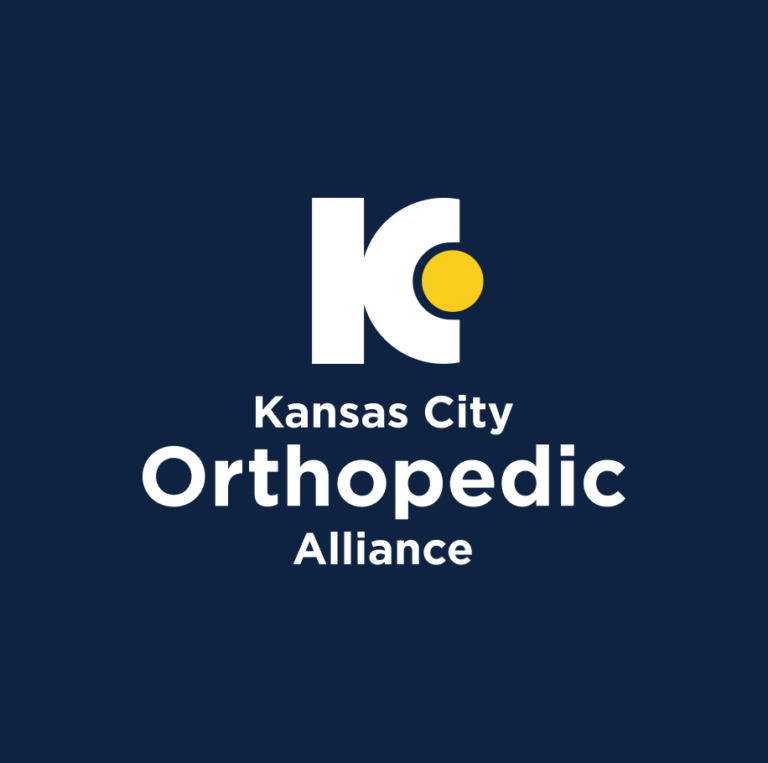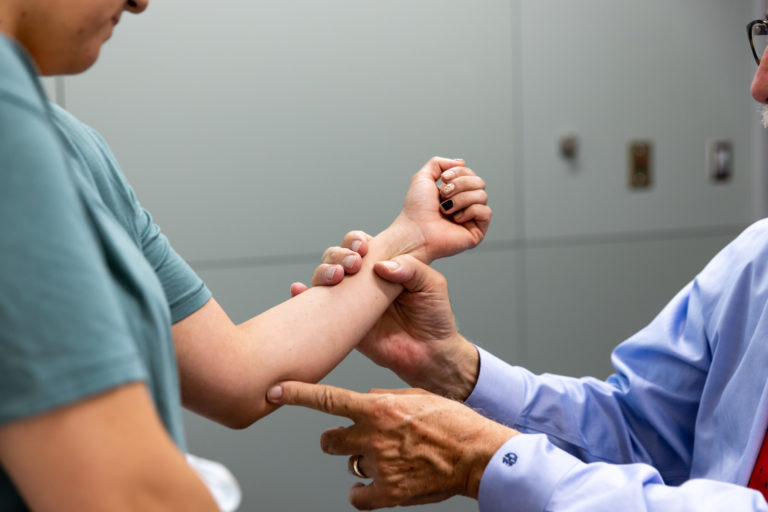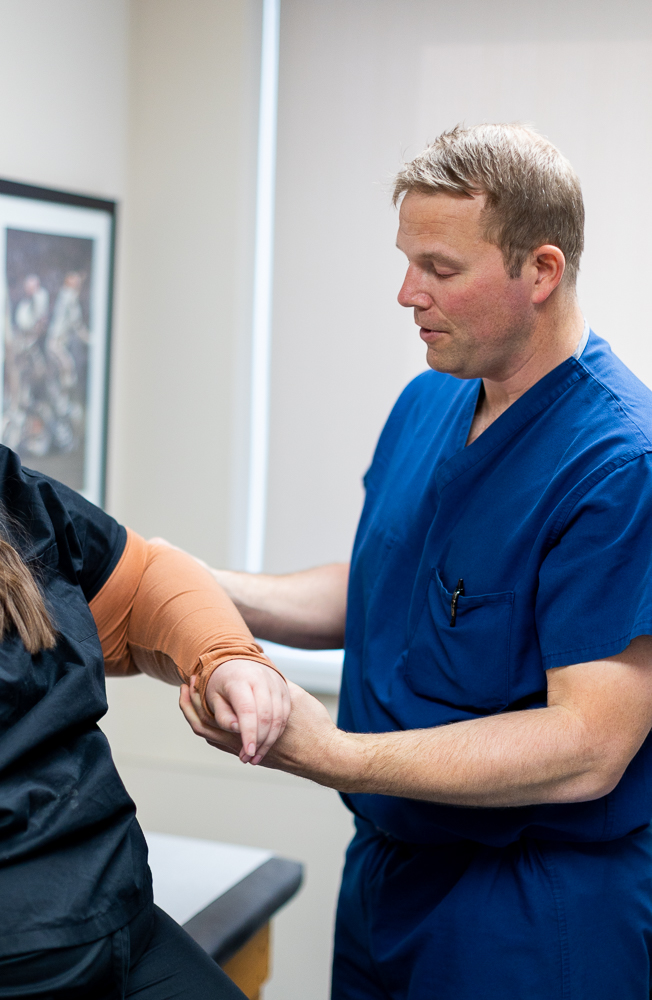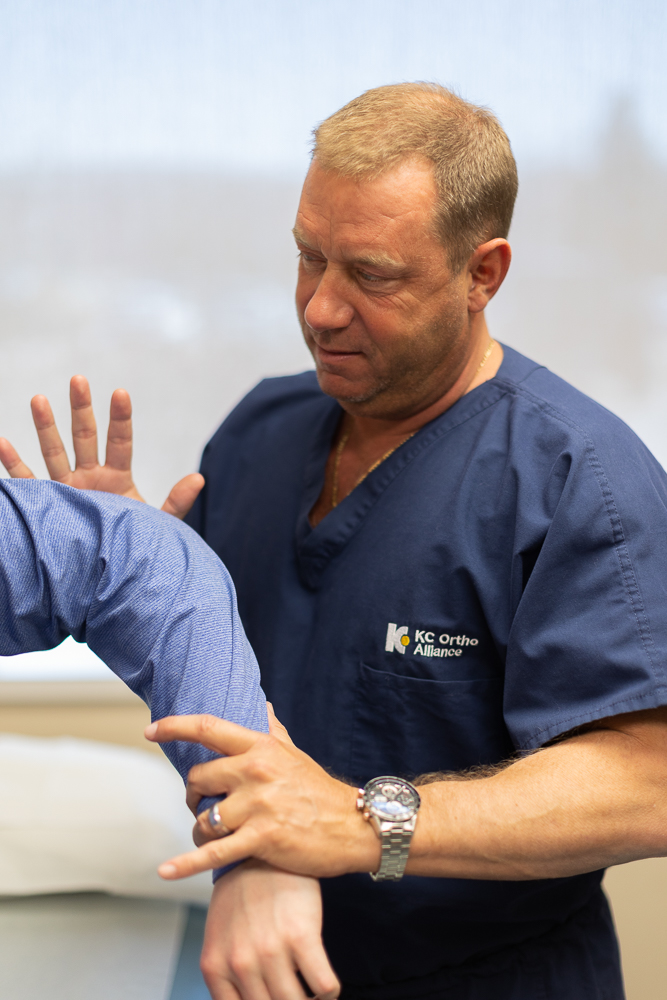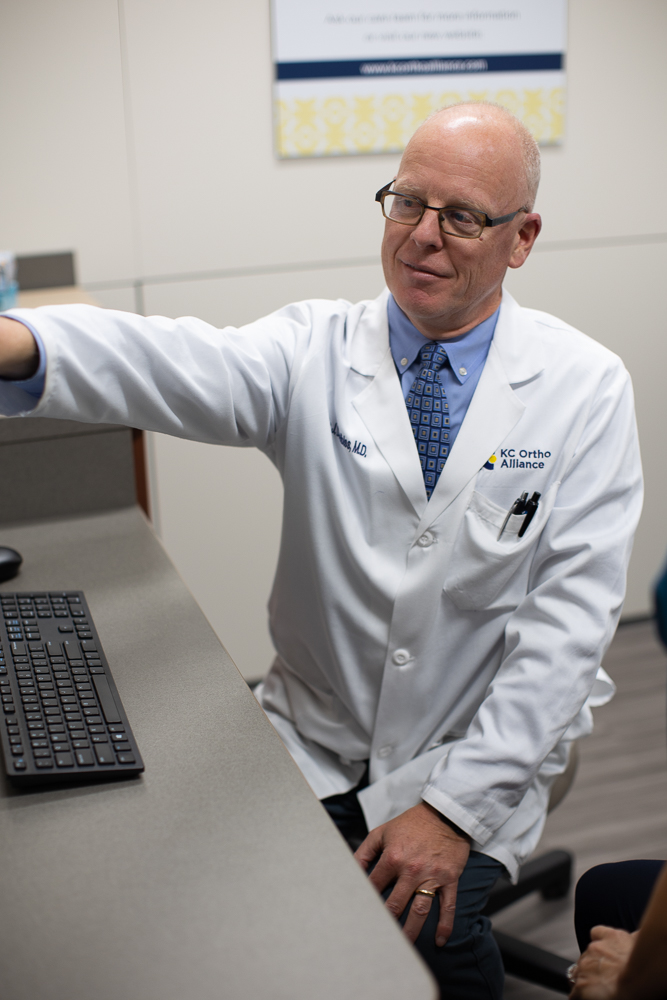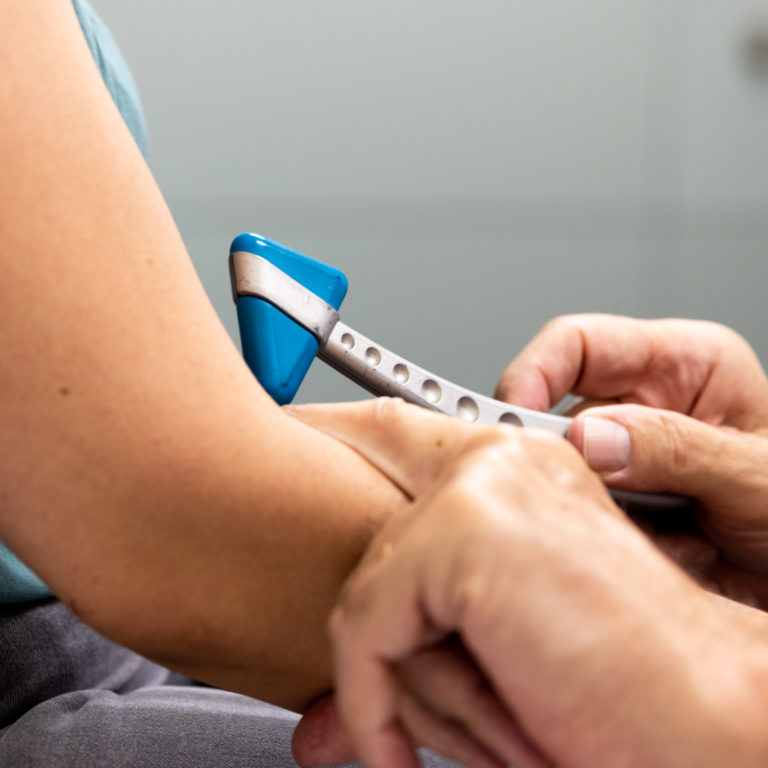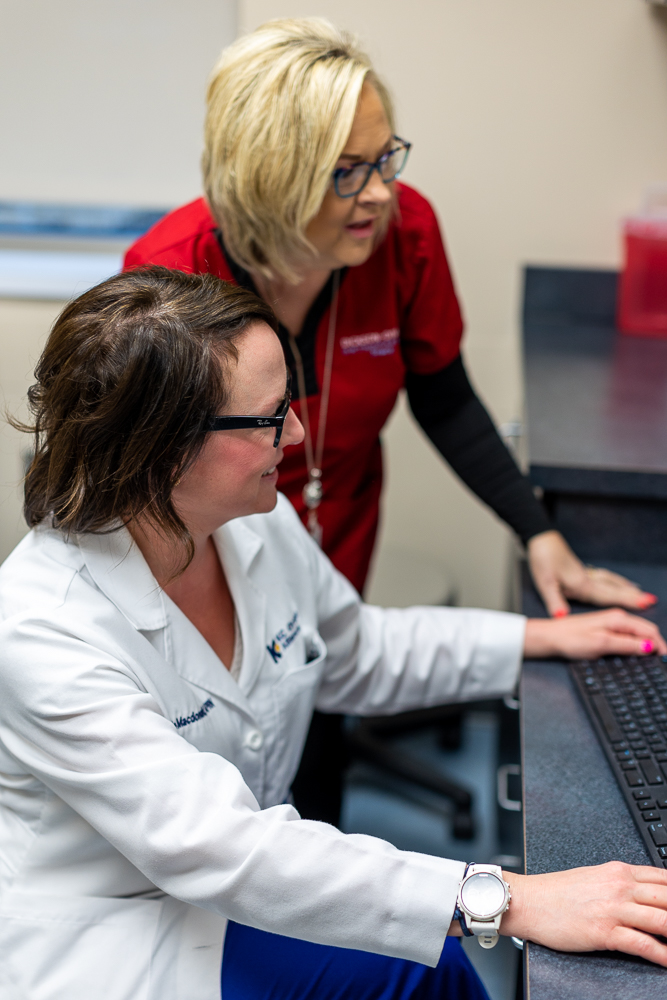Elbow Arthroscopy in Kansas City
Elbow Arthroscopy
Trusted solutions for arm and elbow pain.
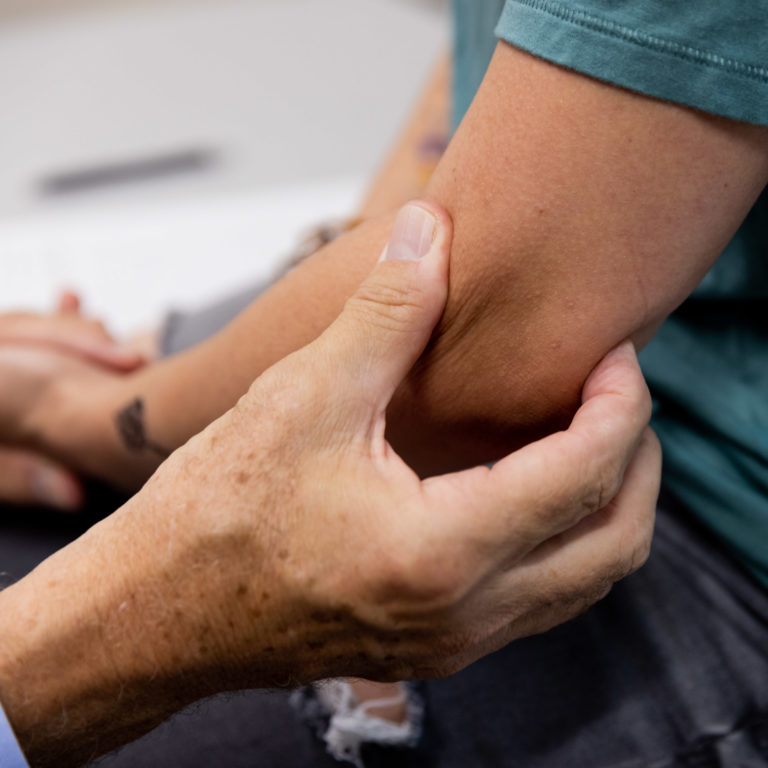
Understanding the Basics Behind Elbow Arthroscopy
What is Elbow Arthroscopy?
Your body relies on many joints to function properly, but sometimes those joints give out from wear and tear.
Pain in the elbow joint can make even everyday tasks more difficult. An elbow arthroscopy in Kansas City from Kansas City Orthopedic Alliance is a safe and effective way to treat elbow issues without the need for an open surgery.
Arthroscopy is a minimally invasive procedure that allows surgeons to see inside the joint. After your initial examination with a KCOA physician, we will recommend the best treatment for your needs. Our practitioners provide the comprehensive care you need so you can return to the activities you enjoy.
Choosing elbow arthroscopy in Kansas City is a decision that typically involves guidance from your primary care doctor and orthopedic physician.
When you choose Kansas City Orthopedic Alliance, one of our highly trained orthopedic elbow specialists will conduct an initial evaluation to better understand your condition. After a complete review of your results, your provider will then discuss whether elbow arthroscopy is the best treatment option for you.
Potential indicators that someone may require elbow arthroscopy include:
- Reduced range of motion
- Swelling
- Weakness
- Stiffness
- Completely immobile or “locked” joint
Kansas City Orthopedic Alliance Elbow Injuries Assessment
Assessing the Injury
Finding the right elbow treatment in Kansas City starts with an assessment.
You can think of elbow pain as a spectrum, with some instances being more severe than others. The KCOA orthopedic specialists always focus on each individual patient and their concerns before creating a treatment plan.
Therefore, during your initial appointment, we will often ask questions such as:
The answers to these questions help shape the next steps of the assessment process and guide our physical examination. After a proper assessment, we often begin with a physical examination to help determine the origin point of your pain. In some cases, advanced testing may be required for a full diagnosis.
- Does your pain currently limit you or your activities?
- Has your pain progressed or worsened recently?
- Have you experienced any tingling or numbness in your arm or fingers that makes tasks difficult?
- Have you noticed any change in your symptoms that has made it more challenging to function?
- What are your lifestyle goals?
- How has pain affected those goals?
Examination
X-Ray
Also called radiographs, an X-ray captures a picture of the hip. Orthopedic physicians may order an X-ray to rule out the possibility of a fracture (broken bone), osteoarthritis, or other hip-related conditions.
Magnetic Resonance Imaging (MRI)
MRI captures images of muscles, bones, intervertebral discs, and tendons to help provide information other tests can’t detail. During an MRI, you will lie on a table that slides into a tube-shaped scanner. The machine creates a magnetic field around you, using pulsed radio waves to form the MRI images.
Electromyograms (EMG) and Nerve Conduction Studies
Our board-certified physiatrists utilize electromyograms (EMGs) and nerve conduction studies to help determine whether nerves and muscles respond properly to stimuli. The EMG measures the electrical activity of your muscles at rest and in motion, while nerve conduction studies determine how fast and effectively your nerves and muscles receive electrical signals.
Symptoms
Common Signs and Symptoms of Elbow Injuries
With so many different parts working together in your elbow, there are many potential causes of elbow pain. And each of those causes has a unique set of symptoms.
Elbow injuries often cause a numbness or tingling sensation in your arm, which can slow your arm function down and make tasks more difficult. When a patient visits one of our KCOA offices, a skilled orthopedic specialist will ask you questions regarding your symptoms, what aggravates/alleviates your symptoms, and whether you have attempted prior therapies. Next comes a thorough physical exam. We will then review any images you bring with you and/or take new images. After determining the cause of your pain, we can then discuss if elbow arthroscopy will work best for your needs.
Causes
Causes of Elbow Pain
The body has different kinds of joints, and they all face different challenges. The elbow is a complex joint that connects 3 different bones: the humerus (upper arm), ulna (pinky side forearm), and radius (thumb side forearm). Covering the surface where these bones meet is articular cartilage, a smooth substance that protects the joint by cushioning and absorbing forces.
On the inside and outside of this joint are ligaments that hold the elbow together and prevent dislocation. Muscles also surround the elbow on the front and back sides, and there are 3 major nerves that cross the elbow joint.
Elbow pain can come from a variety of issues with any of these working parts of the joint. Most elbow pain stems from overuse, either in a sport or other repetitive movements that cause strain on the joint.
Treatment Alternatives
Non-Surgical Options
Surgery, even minimally invasive ones like elbow arthroscopy, isn’t necessarily the first choice. Kansas City Orthopedic Alliance physicians prefer a more conservative approach to treatment, so we will typically exhaust all non-surgical options before recommending surgery. Non-surgical treatments for shoulder injuries include:
-
Physical Therapy – Seeking out guidance from a trained therapist to help restore function and strength is often a preferred treatment. Therapists are experts in the musculoskeletal system and their ability to assist with manual techniques or exercise instruction can lead to excellent outcomes.
-
Medications – At times, the pain becomes too much and hinders movement. In those instances, your doctor may recommend over-the-counter NSAIDs (Non-steroidal anti-inflammatory drugs, such as Advil) or prescription medications. Especially with NSAIDs, you should always talk to your doctor to ensure they are the right treatment for you. Side effects can include stomach irritation, ulcers, or even kidney damage. Reasonable dosing and monitoring can help alleviate those side effects.
-
Injections – Cortisone injections can help with inflammation, and the effects tend to last for 3 to 6 months before you might need another one. Many people manage their pain with injections and exercise.
-
Regenerative Medicines – Regenerative medicines like stem cell injections or platelet-rich plasma can help nourish worn or damaged tissue. This option works best if you have mild-to-moderate hip pain.
F.A.Q.
Frequently Asked Questions
Kansas City Orthopedic Alliance is here to help.
Our care is personal. Our team is knowledgeable. And we’re more available than ever.
With access to board-certified specialists across Kansas City, we have the tools to meet almost every musculoskeletal condition.
Our Locations
Overland Park, Kansas
10777 Nall Ave Suite 300 Overland Park, KS 66211Leawood, Kansas
3651 College Blvd. Leawood, KS 66211Kansas City, Missouri
Saint Luke's Medical Plaza #1 4320 Wornall Rd., Ste. 610 Kansas City, MO 64111Belton, Missouri
Belton Regional Campus 17067 S Outer Rd #301 Belton, MO 64012Blue Springs, Missouri
St. Mary’s Medical Center, Main Entrance 203 NW R.D. Mize Road, Suite 200 Blue Springs, MO 64014Shawnee Mission, Kansas
7450 Kessler St ste. 140 Merriam, KS 66204Prairie Star (Lenexa, Kansas)
Prairie Star 23401 Prairie Star PkwyBldg. B, Ste. 220 Lenexa, KS 66227
